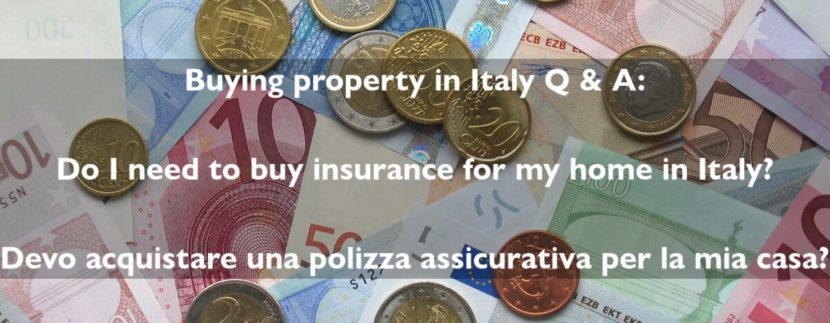Do I need to buy insurance for my home in Italy?

Home owner's insurance is not required by law, and indeed few Italians buy insurance for their homes; about half who have insurance only have it as it was required by their bank for their mortgage.
Policies tied to mortgages will likely be limited in what they cover and will likely be limited to the length of the mortgage; it is possible to stipulate a more extensive policy provided by a different company than that proposed by the bank – verify this with your bank.
In the euphoria of purchasing a new home, it can be too easy to overlook the importance of protecting it, and you and your loved ones, from unfortunate future events.
Formal condominiums with an administrator will generally have coverage for the overall building and for damage to or by the shared parts (ask the administrator for details).
Property owners will want to consider obtaining insurance covering:
- the property itself
- damage to others, e.g. water from a leaky pipe floods the neighbors below or a roof tile falls on someone
- personal possessions and property
Risks to consider covering include fire (less of a concern in masonry buildings than in timber construction), theft, explosion (e.g. gas) and "natural" calamities, including, depending on the area, earthquakes and flooding. Avoid being penny-wise and pound foolish: there may be temptation to save on a premium by choosing low coverage values yet this can come back to haunt you.
Insurance policies are not generally retroactive – insurance needs to be in place before an event happens.
In selecting an insurance company it is important to consider:
- what is covered
- what restrictions limit coverage: deductibles, coverage limits, other "fine print"
- policy cost
- does the company actually pay claims when one arises?
An inexpensive policy from a company which doesn't want to pay valid claims is actually a very expensive policy in reality.
One of the large consumer associations in Italy, Altroconsumo, offers its members an overview of available policies with ratings. My sense is Altroconsumo is not as "rigorous" as Consumer Reports in the US or Which? in the UK, but it is about the best we have here.
The UK Insurer Aviva has sold their Italian business to the German Allianz – it remains to be seen how Allianz performs, particularly regarding claims.
The government will often provide support in the case of a natural calamity such as a major flood or earthquake. However this is not guaranteed and it can take a very long time for the payout – private insurance is probably still a good idea.
Policies are sold both directly (online) and through brokers. While a broker may cost a bit more, they could be well worth their value in supporting you should you have a claim.
Evaluating risks
Italy uses a scale of 1 to 4, assigned at the town level, to indicate earthquake risk, where 1 is high and 4 is very low. Data is available from Italy's protezione civile.
Regional, and perhaps town, maps probably exist with flood or other geological risk information.
Theft may happen anywhere and is probably no more common than in other countries. Thieves will generally want small high value items such as luxury watches and gold items. Be especially attentive to not leave these items in plain sight when other people are in the home, such as workmen. Installing a safe may actually alert third parties to the presence of valuables.
❖ ❖ ❖
The above is offered as general guidance without warranty; changes may have occurred since it was written. Do consult with appropriate qualified professionals regarding your specific situation before making any real estate purchase.
About the author

Sean Michael Carlos grew up in Rhode Island, USA. He studied in the US, UK and Germany before settling in Italy where he has lived for over twenty-five years, in three different regions.
Sean is a licensed real estate agent in Italy with over 10 years experience in the sector and would love to hear from you if you are looking to buy or sell property in Italy.





































